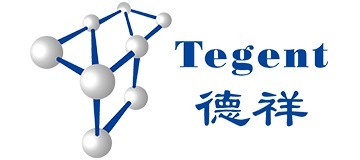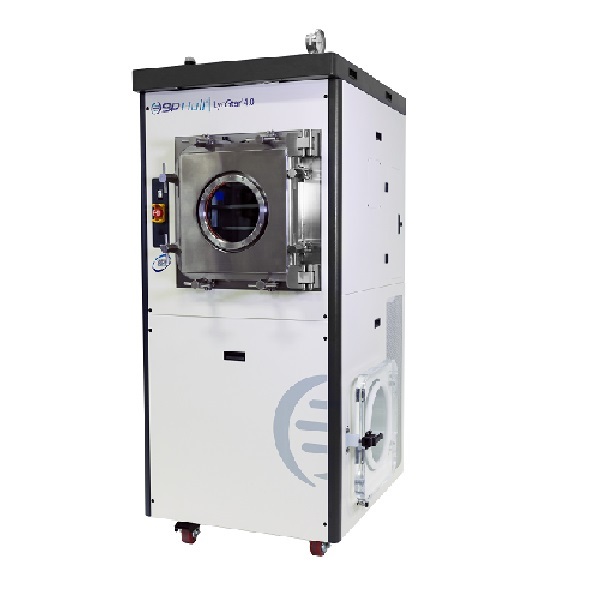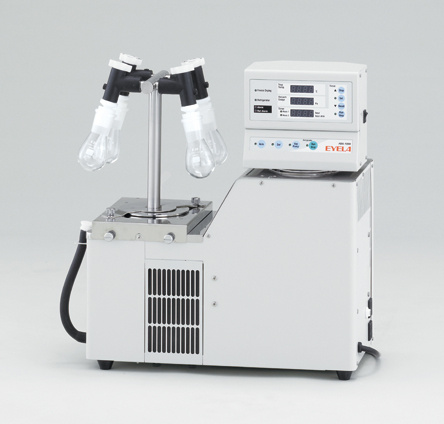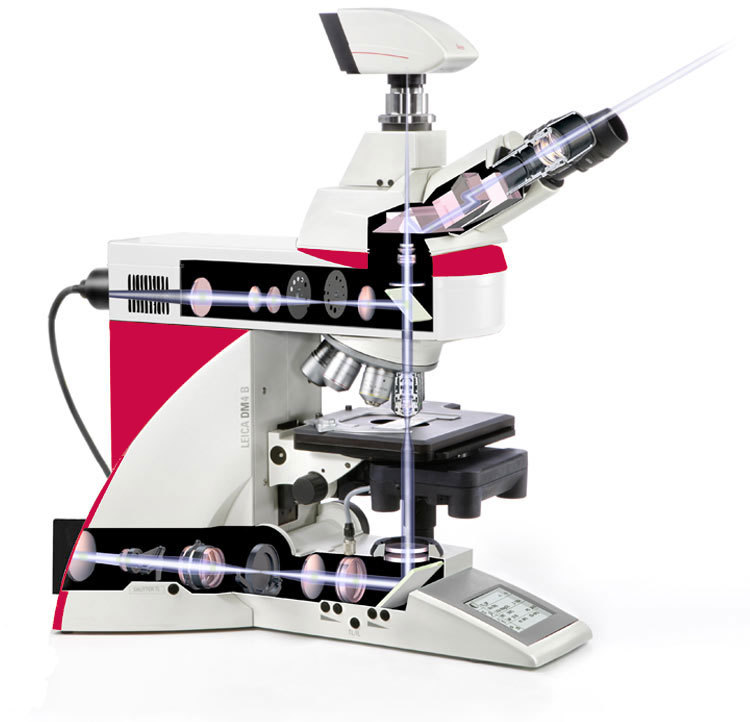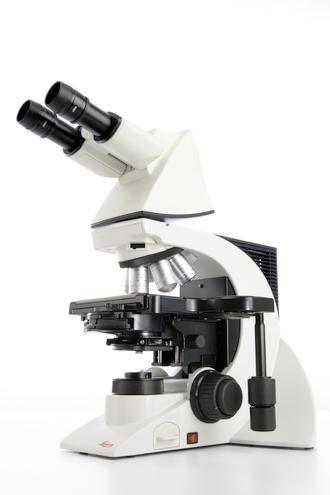
方案详情
文
稳定冻干蛋白配方的合理设计方面的实用建议 Rational Design of Stable Lyophilized Protein Formulations
方案详情

稳定冻干蛋白配方的合理设计方面的实用建议 Rational Design of Stable Lyophilized Protein FormulationsPharmaceutical Research, Vol. 14, No. 8,1997Click Here To Link to SpringerLink.com for Article Reprints and PermissionsReview Article 970Carpenter, Pikal, Chang, and Randolph Rational Design of Stable Lyophilized Protein Formulations:Some Practical Advice John F. Carpenter,12.6 Michael J. Pikal, Byeong S. Chang, and Theodore W. Randolph1,5 Received March 7, 1997; accepted May 15, 1997 KEY WORDS: protein drugs; design of formulations; lyophilization; stabilization of proteins. WHY USE LYOPHILIZATION TO PREPARE STABLE PROTEIN DRUG PRODUCTS? Early in the development of a protein therapeutic it is essential to design a formulation that is stable during shipping and long-term storage. Obviously, an aqueous liquid formula-tion is the easiest and most economical to handle during manu-facturing, and is the most convenient for the end user. However, many proteins are susceptible to chemical (e.g., deamidation or oxidation) and/or physical degradation (e.g., aggregation and precipitation) in liquid formulations (1,2). It may be possible to design an aqueous formulation to slow protein degradation adequately, under controlled storage conditions (i.e., constant temperature and minimal agitation). However, during shipping, when precise control of conditions is not always feasible, prod-ucts can be subjected to numerous stresses that denature pro-teins. These include agitation, high and low temperatures, and freezing (2). Furthermore, although a formulation and shipping system might be designed to circumvent damage from these stresses, it still may not be possible to inhibit damage suffi-ciently during long-term storage. For example, there are cases where conditions that minimize chemical degradation foster physical damage and vice versa (1,2). Then, conditions that provide a compromise affording the requisite long-term stability cannot be found. All of these difficulties theoretically can be avoided with a properly prepared lyophilized formulation. In the dried solid, degradative reactions can be avoided or slowed sufficiently, such that the protein product remains stable for months or years at ambient temperatures (3-6). Furthermore, short-term University of Colorado Center for Pharmaceutical Biotechnology, School of Pharmacy, University of Colorado Health Sciences Center, Denver, Colorado 80262. Department of Pharmaceutical Sciences, School of Pharmacy, Univer-sity of Colorado Health Sciences Center, Denver, Colorado 80262. School of Pharmacy, University of Connecticut, Storrs, Connecti-cut 06269. 4 Amgen, Inc., Thousand Oaks, California. Department of Chemical Engineering, University of Colorado, Boul-der, Colorado. 6 To whom correspondence should be addressed. (e-mail: John. Carpenter@UCHSC.edu) excursions in temperature control during shipping are usually not damaging to a lyophilized protein (6). Even in cases where two, or more, degradative pathways require different conditions for maximum thermodynamic stabilization, the reduced reaction rates in a dried product can allow for long-term stability. Thus, in general, whenever preformulation studies indicate that suffi-cient protein stability cannot be achieved in aqueous liquid ormulations, lyophilization providesthe 1OSI attractive alternative. However, lyophilization requires sophisticated processing and is time consuming and expensive, relative to simply filling vials with a liquid formulation (3-10). Also-of greatest con-cern for the current review--without appropriate stabilizing excipient(s) most protein preparations are at least partially dena-tured by the freezing and dehydration stresses encountered dur-ing lyophilization (2,3-6,11-16). The result is often irreversible aggregation of a fraction of the protein population, either imme-diately after processing or after storage (e.g., 15,16). Because most protein drugs are delivered parenterally, only a few percen of aggregated protein will be unacceptable. Finally, simply designing a formulation that allows the protein to survive the lyophilization process does not assure stability during long term storage in the dried solid (6,13-16). A poorly formulated lyophilized product, in which the protein is sufficiently reactive to require storage at subzero temperature, should not be consid-ered a success. The purpose of this mini-review is to provide some practi-cal guidelines for designing formulations that protect proteins during freezing and drying, and that are stable during shipping and long-term storage at ambient temperatures. Also, as will be discussed briefly, formulations must be designed with consid-eration of the physical constraints on processing conditions needed to obtain a proper final cake with a low residual mois-ture. All of these issues have been reviewed previously in detail (3-10). Furthermore, relevant new reviews by us and others will appear this year in books edited by Vincent Lee and Louis Rey. We will not discuss the design and optimization of lyophili-zation cycles. Nor will we digress from practical advice abou excipient choices to address the debates about the mechanisms by which these compounds stabilize proteins (see 2,5,6,11-16). The pharmaceutical scientist who has had extensive experience bringing lyophilized protein products to market may not benefit greatly from this review. Rather, our goal is to provide a starting point for the researcher for whom design of stable lyophilized protein formulations is still a new and major challenge. WHAT CONSTRAINTS GOVERN THE DESIGN OF THE FORMULATION There are so many factors to consider when designing a proper lyophilized formulation, that the task when viewed as a whole can appear overwhelming. This need not be the case, if the major constraints governing success are well understood. Protein Stability First, it must be remembered that the whole reason for lyophilizing the product is because the protein of choice is unstable. The most sensitive element in the formulation is the protein, and the primary concern in formulation design must be the choice of excipients that provide optimal stability. This is the issue on which we will focus in detail below. Final Product Configuration Secondly, the final product configuration must be clearly defined prior to starting formulation efforts. Issues to be consid-ered include route of administration, which is often parenteral, other agents to be co-administered to the patient, product vol-ume, protein concentration, and whether the product can be lyophilized in vials or whether alternative systems such as syringes must be employed. Also, if the final product is intended for multi-use, it will necessary to include a preservative in the formulation, which may reduced protein stability. Formulation Tonicity In choosing excipients, designing an isotonic solution might be a concern. Mannitol or glycine are usually good choices as tonicity modifiers. As explained below, these excipi-ents are often preferable to NaCl, which due to its relatively low eutectic melting and glass transition temperatures, can make a formulation more difficult to lyophilize properly (3-10,17-20). Also, if the product has a relatively low mass of protein per vial, often it will necessary to have a bulking agent in the formulation to prevent the protein from being lost from the vial during drying (e.g., 4-6). Mannitol or glycine can also serve this role because they usually crystallize to a substantial degree during lyophilization and form a mechanically strong cake (4-6). However, it must be realized that crystalline excipients when used alone will usually not provide adequate stability to most proteins during processing or storage in the dried solid (12-14). Cake Structure Finally, the dried product must have an elegant cake struc-ture, which is mechanically strong and has not undergone any collapse and/or eutectic melting and in which the residual mois-ture is relatively low (ca. 1 g H20/100 g dried solid). If the product collapses, it will not only be aesthetically unacceptable, but also it could have excessively high residual moisture, and reconstitution time will be prolonged (3-6,17,18). Product Glass Transition Temperature Also, to assure long-term stability of the protein in the dried solid, the glass transition temperature (Tg) of the amor-phous phase in the product, which contains the protein, must exceed the planned storage temperature (4-6,14-16). Since water is a plasticizer of the amorphous phase (3-6,9,17,18), low residual moisture is needed to insure that Tg is greater than the highest temperature encountered during shipping and storage (usually greater than 40℃). Product Collapse Temperature In general, achieving these goals requires maintaining the product temperature below its glass transition temperature dur-ing the lyophilization cycle (3-10,17,18). During primary dry-ing, when ice is sublimed, the product must be maintained below the collapse temperature, which usually coincides with the thermotropic transition that has been referred to the glass transition temperature of the maximally freeze-concentrated amorphous phase of the sample (Tg) or as the softening temper-ature of the amorphous phase (Ts) (3-10,17,18). Also, it is necessary to keep the product temperature below the eutectic melting temperature of any crystalline component. In practice, these temperatures can be determined using either differential scanning calorimetry (DSC) or freeze-drying microscopy. The ability to determine collapse temperature is essential to formula-tion development (19,20). Drying a product below the collapse temperature carries a price (3-10). The lower the sample temperature, the slower and more expensive the drying cycle becomes. In general, freeze-drying below -40℃ is not practical (3-10). Also, there are physical limits in the temperatures to which samples can be reduced, which are dependent on the lyophilizer and sample configuration (3-10). As the formulation is being developed, the pharmaceutical scientist should work closely with the process engineers, who will be designing the lyophilization cycles. It is especially important to know how the large-scale lyophilizers, which will be used for commercial production, compare to the research-scale unit that is used during formulation development. Often, the large units do not have the same level of control of process parameters as do the small research units, and in part due to the large size of a production unit, intervial variation in product temperature during the process may be greater. Finally, input from a researcher knowledgeable in the physics of freeze-drying will help prevent the formulation scientist from arbi-trarily rejecting useful formulations. There are ways (see reviews 3-10) in which the process parameters can be manipu-lated such that relatively rapid and controlled drying can be achieved with products that have relatively low collapse temperatures. It is clear that one goal of formulation design is to provide the highest collapse temperature that is practical, within the constraints of maintaining protein stability. The collapse tem-perature (i.e., the Tg’) of the product will be dictated primarily by the formulation composition. If the protein is present at a level exceeding about 20% (wt/wt) of all solute it can have a relatively large effect on Tg’. Although it is often difficult to measure the Tg’ of pure protein solutions with DSC, it has been found that adding increasing amounts of protein to most formulations leads to a higher Tg’(S.D. Allison, B.S. Chang, T.W. Randolph, M.J. Pikal and J.F. Carpenter, unpublished observations). By extrapolation it appears that pure protein solutions have a Tg’ of about -10℃, which is much higher than that of most pure excipient solutions (e.g., Tg’ of sucrose is about -32℃). Thus, from a process economy viewpoint, one desires a high ratio of protein to stabilizer in the formulation (cf. 6). However, stability normally increases as the weight ratio of stabilizer to protein increases, so typically a compromise must be made between providing a high collapse temperature and adequate protein stabilization (e.g., 2,4-6,11,16). Also, as will be discussed below, protein resistance to freezing damage often improves as the protein concentration increases (2,6,22). Thus, in general stability is best at both high protein concentra-tion and high weight ratio of stabilizer to protein. Therefore, in turn, stability optimization may lead to very high total solids content, which creates processing difficulties. Formulations with total solids in excess of 10% (w/w) may be difficult to process (3,7-10). Also, the manner in which the formulation is treated prior to applying a vacuum can alter the Tg’. Usually such treatment involves an annealing step, which results in removing some fraction of a given component from the amorphous phase (6). For example, if glycine is used as a crystalline bulking agent, depending on the freezing protocol, a significant fraction of the glycine molecules may remain in the amorphous phase of the sample (6). Glycine has a relatively low Tg' (e.g., ca.-42℃; 6,20). Thus, it is important to crystallize as much as possible, which in turn should increase the Tg’of the amorphous phase and make drying more rapid and economical. To design the optimum protocol for excipient crystallization, DSC can be used to simulate the processing conditions used during freezing and annealing. This approach is described in Carpenter and Chang (6). AT WHAT STEPS IS STABILIZATION OF THE PROTEIN REOUIRED? Essentially every step from vial filling to final reconstitu-tion of the dried product can damage the protein and require formulation components to inhibit degradation (1,2,6,11,21,22). During the rapid steps (e.g., filling, freezing, drying and rehy-dration) the major problem is usually physical damage, which is typically manifested as formation of oligomeric and/or precip-itated protein molecules (1,2,6,15,21,22). Normally the transi-tion from solution to solid slows the rate of physical changes more than it slows chemical changes, so chemical degradation in the dried solid is often the more serious storage stability problem (e.g., 6,15,16). However, protein aggregates can form during storage/reconstitution (e.g., 6,13-16). These degradative processes can be minimized if protein unfolding (here, meaning even a small fraction of the total molecular population) is inhibited during the most damaging stresses of freezing and drying (6,15,16). Thus, a primary focus of formulation design should be protecting the protein during these steps, so that the dried formulation immobilizes the native protein in a chemically inert solid matrix having both high Tg and low residual mois-ture (5,6,14,16). Stabilization During Freezing Whether a given protein is susceptible to freezing damage depends of many factors, beyond the inclusion of the appropriate stabilizers (see below) in the formulation. In general, the three most important parameters to consider are protein concentra-tion, buffer choice, and freezing protocol (2,6,21-24). Increasing protein concentration leads to increased resis-tance to denaturation during freezing (2,6,22,24). This phenom-enon can be demonstrated by simply determining the percentage protein aggregated after freeze-thawing, which varies inversely with protein concentration (e.g., 22). Normally, it would be expected that increasing protein concentration would increase aggregation, and this would be the case if the fraction of protein molecules unfolded during freezing were independent of con-centration. However, it is now thought that increasing protein concentration directly reducesSfreezing-induced protein unfolding. It has been speculated that damage during freezing involves protein denaturation during formation of the ice-water interface (21,22). Assuming that only a finite number of protein molecules can be denatured at this interface, then increasing the initial protein concentration will lead to a smaller percentage of damaged molecules. For practical purposes, it is sufficient simply to consider protein concentration as an important vari-able to examine, and to include the highest possible concentra-tion in testing during formulation development. Buffer choice can also be critical. The main culprits here are sodium phosphate and potassium phosphate, which can undergo drastic changes in pH during freezing and annealing(6,23,24). With sodium phosphate, the dibasic form will readily crystallize, resulting in a frozen sample in which the pH in the remaining amorphous phase (containing the protein) can be reduced to 4 or lower (23,24). With potassium phosphate, the dihydrogen salt crystallizes, giving a final pH near 9 (23,24). The risk of alteration in pH and its damage to proteins can be minimized by increasing the initial cooling rate, limiting the duration of annealing steps and minimizing the buffer concen-tration, all of which reduce opportunity for salt crystallization (6,24). Rapid freezing, without annealing also limits the length of exposure of protein to denaturing conditions in the frozen state 6,24). Although other excipients can aid in inhibiting the pH change (24), the best approach is to avoid using sodium phosphate or potassium phosphate buffers. Buffers that have minimal pH change upon freezing include citrate, histidine and Tris (22,24; T.J. Anchordoquy and J.F. Carpenter, unpub-lished observations). In studies in which complications due to buffer pH changes have been avoided, it has been found that the degree of protein damage during freezing correlates directly with cooling rate, with more damage found at higher cooling rates where surface area of ice is larger (21,22). It has been speculated that this is due to protein denaturation during the formation of the ice-water interface (21,22). More rapid cooling leads to smaller ice crystals, which have a greater surface area to volume ratio than larger crystals. Since cooling rates will usually be dictated by the physical constraints of the lyophilizer, excessively rapid cooling probably will not be a problem (3-10). However, some proteins are so sensitive to freezing, that even with slow, con-trolled cooling they will be denatured (e.g., 21,24). Stabilization During Drying and Storage in the Dried Solid Even if the entire population of protein molecules survives the freezing step, there will be denaturation during subsequent dehydration, unless the appropriate stabilizers are added (15,16,25-28).Simply stated, removal of the protein molecule’s hydration shell, which occurs during lyophilization, destabilizes the native conformation (15,16,25-28). To date, infrared spec-troscopic studies with dozens of proteins have shown that, in the absence of the appropriate stabilizer(s) (e.g., sucrose) pro-teins will be unfolded in the dried solid (15,16,25-28). If sam-ples are rehydrated immediately, the degree of damage (e.g., percent of aggregation) correlates directly with how “non-native” the infrared spectrum of the dried protein appeared (15,16,25-28). Thus, reducing post-rehydration damage is dependent on minimizing the unfolding during freezing and drying. Moreover, even if 100% native molecules are recovered in samples rehydrated immediately, there can be a substantial fraction of unfolded molecules in the dried solid (15,16,25-28). Intramolecular refolding during rehydration can dominate the intermolecular interactions leading to aggregation, thereby giv-ing 100% native protein on reconstitution. Fortunately, appropriate excipients can prevent or at least minimize unfolding, and the success of the formulation can be judged immediately by examining the protein secondary structure in the dried solid with infrared spectroscopy (15,16,25-28). More importantly, in the few studies published to date, it has been shown that stability during long-term storage in the dried solid is dependent of retention of native protein during freeze-drying (15,16). Even for samples stored at temper-atures well below the formulation Tg, damage arose rapidly (e.g., within weeks) if the protein was unfolded in the dried solid. Therefore, infrared spectroscopy, which can be used immediately after lyophilization to determine if protein unfolded has arisen, should be considered another essential tool for the protein formulation scientist. WHICH EXCIPIENTS ARE THE BEST FIRST CHOICES? After this review of all of the dangers of lyophilization and all the factors to be considered it might seem that rapid development of a stable lyophilized formulation would be an impossible task. Fortunately with a rational approach to formu-一 lation design, most formulation problems are quickly resolved. Here we will provide the rationale for the initial choices of formulation components. In some cases, the “initial formula-tion” may be all that is needed for the final marketed product. The composition to be given, with various minor modifications, has already been used with success with protein drugs (e.g.,16). We wish to stress that for any lyophilized formulation, the minimum number of components necessary for protein stability and cake structure should be used. No excipient should be added unless there are data to document that it has a beneficial role in the formulation Specific Conditions for Stability of a Given Protein Before choosing the appropriate “general” stabilizers, which are effective at protecting most proteins, it is absolutely essential that the formulation be optimized for the specific factors that increase the physical and chemical stability of a given protein. For example, simply avoiding extremes in pH can drastically reduce the rate of deamidation (1). Moreover, it has been found that the resistance of a protein to unfolding during freeze-drying can be dramatically increased by optimiz-ing the pH of solution (e.g., 15). Also, other specific ligands that increase protein stability (e.g., by increasing the free energy of unfolding) should be investigated. The stabilizing effects of heparin and other polyanions on growth factors (e.g., 29) pro-vide a good example. Another important factor to be considered is the effect of ionic strength on protein unfolding and aggrega-tion. It must be recognized that during freezing, the ionic strength may increase 50-fold as ice formation concentrates all solutes (5,6,9,19). The persons responsible for bulk drug purification and pharmaceutical preformulation often already have insight into these issues. Thus, it is imperative that the formulation scientist confer with these people, prior to embarking of design of a lyophilized formulation. Even with specific solution conditions optimized for pro-tein stability, it probably will be necessary to add other protec-tive excipients, if the protein is to survive lyophilization and long-term storage in the dried solid. First, let us consider some compounds that have been used for lyophilized protein formula-tion but which do not provide stability and may actually foster damage during storage. We will then provide an outline of a simple, but effective formulation, and the rationale for the choice of the components will be discussed. Excipients that Can Fail to Stabilize Proteins With the goal of obtaining a strong cake structure during a rapid lyophilization cycle, polymers such as dextran and hydroxyethyl starch, which have relatively high collapse tem-peratures, are attractive excipients. Also, the Tg of the final dried product will be high (e.g.,>90℃) with these polymers(15). Unfortunately, these polymers do not inhibit protein unfolding during lyophilization and they typically fail to provide stability during subsequent storage (15,30). The failure to inhibit lyophilization-induced denaturation is presumably because the polymers are too bulky to hydrogen bond to the protein in the place of the water that is lost during dehydration and/or because the polymers form a separate amorphous phase from the protein (5,6). Although when used alone such polymers are not good choices as stabilizers, as described below, they could be prove usefulincombinationVwithcertain disaccharideprotein stabilizers. Among the numerous compounds tested it appears that the most effective stabilizers during the lyophilization cycle are disaccharides (2,5,6,11,15,16,25-28). However, one group of compounds that should be avoided are the reducing sugars. These compounds may effectively inhibit protein unfolding during the lyophilization cycle, but during storage in the dried solid they have the propensity to degrade proteins via the Mail-lard reaction between carbonyls of the sugar and free amino groups on the protein (31). The result can be a brown syrup containing degraded protein instead of a white cake containing active protein drug. Usually, the only way to slow this process significantly is to store the product at subzero temperatures, which defeats the purpose of a lyophilized product. Compounds in this undesirable category include glucose, lactose, maltose and maltodextrins. As noted earlier, crystalline bulking agents such as manni-tol and glycine do not provide protection during lyophilization (6,11,12,25).However, some effective lyophilized formulations employing mixtures of these two agents have been developed and marketed. In these cases the appropriate ratio of manni-tol:glycine led to a significant fraction of the compounds remaining amorphous (e.g., 30). Presumably this amorphous fraction was sufficient to inhibit protein unfolding during lyoph-ilization and to provide stability during long-term storage. How-ever, we caution against such an approach because achieving just the right processing conditions, in combination with the appropriate excipient ratio, can be time consuming and tricky. Rational Choice of Stabilizing Excipients So what are appropriate, rational choices for excipients? To provide a concrete example, let’s make the following assumptions about a fictitious case. 1) The protein drug will be formulated at 2 mg/ml. 2) The major routes of degradation are aggregation immediately after lyophilization/rehydration and deamidation during storage in the dried solid. 3) Optimizing specific conditions (e.g., using a citrate buffer at pH 6.0) only reduces aggregation upon freeze-drying and reconstitution to about 10% and deamidation still proceeds at an unacceptably rapid rate during storage, even when the product is stored 20℃below its Tg. 4) A crystalline bulking agent (e.g., mannitol) is desired to form a mechanically strong and elegant cake. At this point, the major component missing is a nonreduc-ing disaccharide, which forms an amorphous phase with the protein in the dried solid and serves as the primary stabilizer. The main choices are sucrose or trehalose (5,6). These com-pounds are relatively effective at protecting proteins during freezing and usually excellent at inhibiting unfolding during dehydration (5,6,15,16,25-28). Freezing protection depends on the initial bulk concentration of the sugar, and sometimes con-centrations exceeding 5% (wt/vol) are needed to maximize stabilization (2,6). In contrast, protection during drying depends on the final mass ratio between the sugar and the protein (5,6). Generally, a weight ratio of sugar to protein of at least 1:1 is required for good stability, with optimal stability being reached at around 5:1. In practice, it is not necessary to determine the most appropriate concentration for each type of protection. Rather, with the protein concentration held constant, a range of sugar concentrations can be tested during formulation screen-ing to discern the optimal concentration for retention of native protein in the dried solid and the resultant reduction in aggrega-tion upon rehydration. In general, the optimal sugar concentration for stabilizing the protein during lyophilization will also provide storage stabil-ity, if the final dried powder has a Tg well above the storage temperature (5,6,15,16). For example, assuming that a high room temperature of about 30℃ is the maximum intended storage temperature, then a product containing a native protein and with a Tg of > 50℃ should be stable. Since residual moisture lowers Tg, the condition Tg > 50℃ must apply to the maximum water content allowed by the product specifica-tions. It is imperative that DSC be used to measure the Tg of each product to be certain that this goal is achieved. Both sucrose and trehalose have advantages and disadvan-tages. 1) Trehalose has a higher Tg at any moisture content and, thus, is more easily lyophilized (32). In addition, the condi-tion Tg > 50℃ will hold at higher residual water contents for trehalose. However, a skilled process engineer should be able to design economical, effective cycles for either sugar. Also, in products with a relatively high protein concentration, the protein could contribute to an increased Tg, which serves to minimize the advantages of trehalose. 2) Trehalose is also more resistant than sucrose to acid hydrolysis. Hydrolysis of these disaccharides produces reducing sugars, which must be avoided. Usually this is not a problem, unless very low pH’s of around 4 or lower are employed.3) Sucrose appears to be more effective at inhibiting unfolding during lyophilization (unpublished observations). This difference has been most obvious when there is a relatively high protein concentration and a need to employ a relatively high initial concentration of sugar. This need can develop when the protein is very unstable during freezing and/or there is a relatively high protein content in the dried solid. Evidence to date indicates that less effective stabilization by trehalose is due to the greater propensity of this sugar to phase separate from polymers (e.g., the protein in a formulation) during freezing and drying (S.D. Allison, T.W. Randolph, B.S. Chang and J.F. Carpenter, unpublished observa-tion). Whether this is a problem with a given formulation cannot be predicted. Hence, the capacity to protect a protein must be examined for each formulation. 4) Sucrose is commonly used in parenteral products that are approved by the Food and Drug Administration (33). In contrast, trehalose has not yet been used in an approved product, probably because to date there has not been sufficient practical benefit to justify using this sugar in place of sucrose. Safety of trehalose will most likely not be a concern. Thus, if there is a clear advantage of trehalose over sucrose in a given product, use of trehalose should not hinder regulatory approval. At this point, our example formulation might be complete, as is the case for many proteins. However, let’s assume that even with sucrose completely inhibiting detectable protein unfolding, as assessed with structural analysis of the dried solid with infrared spectroscopy, after rehydration there is still about 1% aggregated protein. Since there are no aggregates in the starting material, it is assumed that at some point during freezing and drying a very small fraction of the protein population was unfolded. During rehydration some of these molecules refolded, but others formed aggregates. This actually appears to be a common problem, as is the formation of aggregates in pro-cessing steps prior to lyophilization. Fortunately, aggregate for-mation can usually be inhibited by including a nonionic surfactant, such as polysorbate (Tween), in the formulation. The required concentrations generally are very low (e.g.,<0.5%wt/vol). The optimal concentration can be discerned by titrating surfactant into the lyophilization formulation containing all of the other components. Excessive amounts of surfactant should be avoided, because these compounds are liquids at room tem-perature, and, hence, if present at high enough concentration they can lower the formulation glass transition temperatures (Tg'and Tg). Usually, however, at the very low concentrations needed to optimize protein stability this is not a problem. The surfactant can be viewed as the“finishing touch". However, often it is advantageous to add the surfactant well before formulating specifically for lyophilization, to inhibit unfolding and aggregation induced by interfaces (e.g., as caused by air bubble entrainment or by vial-liquid interfaces) during processing (34). Most important for our purposes, is the capacity of a surfactant to inhibit the formation of aggregates during lyophilization/rehydration. Currently it is not known at which steps the surfactant’s protection is operative. Surfactants have been shown to reduce protein aggregation during freeze-thawing, and can aid in inhibiting unfolding during the freezing step of lyophilization (22). Also, examination of the aggregate-specific infrared bands in the dried solid has indicated that aggregation arising during lyophilization can be inhibited by a surfactant (22). Finally, aggregation of unfolded molecules during rehy-dration can be inhibited by surfactants, presumably by interfer-ing with intermolecular interactions and/or by serving as wetting agents that hasten the dissolution of the lyophilized cake (22). In cases where it appears that the surfactant is beneficial during rehydration, it may be possible to obtain this effect by including surfactant in the diluent. Determining the mechanisms by which surfactants protect proteins is an important area for future research. The knowledge of when and how surfactants stabilize proteins will greatly increase our capacity to use them rationally to solve practical protein formulation problems. WHAT ARE SOME UNEXPECTED DANGERS? Even if the formulation design given above appears to be successful for a given protein, there are other problems that can lead to failure, especially during long-term storage. First, there are often contaminants in excipients that can lead to rapid chemical degradation of proteins. Sugars and mannitol can contain transition metals, and surfactants (e.g., Tweens) can be contaminated with peroxides, all of which can foster oxidation (35). Further, a recent report showed evidence of a reducing sugar contaminant in mannitol (36). Secondly, moisture transfer from the stopper to the cake during storage can directly damage proteins by allowing water-mediated degradative reactions (5-7, 31). Also, the resultant decrease in the Tg of the protein phase could hasten damage during storage, especially if Tg is reduced to less than the storage temperature. Finally, even if everything appears optimal during storage studies at high temperatures (e.g.,40℃), there is one common, but seldom reported event, that can be disastrous (6). The problem can be illustrated by the following story. Product stored at 40℃ in the laboratory was perfectly stable for several months. During the winter the product retained stability during shipping, and there were no reports of problems from the consumers. However, on occasion during summer, after shipping excessive degradation was found after only 2 weeks storage at room temperature. Examination of the initial dried powder with DSC provided the explanation. It was found that mannitol in the formulation was not completely crystallized, but rather formed a metastable glass with a Tg of about 45℃. When this tempera-ture was exceeded, which can occur during shipping in the summer, the mannitol crystallized. Since mannitol is an anhy-drous crystal, the water originally“associated” with mannitol was sent to the remaining amorphous phase, which lowered it’s Tg. Thus, any stabilization offered by amorphous mannitol was lost, and the water content of the protein phase was increased, both effects accelerating the degradation of protein. This problem can be avoided by using DSC to design an appro-priate annealing protocol to complete mannitol crystallization, which can be implemented prior to primary drying and/or under vacuum after secondary drying (cf. 6). Alternatively, one may be able to adjust mannitol concentration or residual water down, to prevent crystallization even at temperatures around 45℃. WILL THIS APPROACH BE SUFFICIENT FOR A GIVEN PROTEIN DRUG? For many proteins the advice given above will probably lead to a successful lyophilized formulation. However, every protein has unique physicochemical properties and, hence, unique stabilization requirements. Thus, the formulation will have to be “customized" for every protein drug. Combining a detailed knowledge of the protein properties with the rational choice of excipients should allow rapid development of a stable lyophilized formulation. Finally, the compromise between retaining physical propD-erties of the dried cake during a rapid lyophilization cycle and obtaining a native protein after freezing and drying, may become simpler in the future. Recent research has shown that when sucrose is used in combination with dextran the native structure of a protein can be retained in the dried solid, because of the actions of sucrose (S.D. Allison and J.F. Carpenter, unpublished observation). The presence of dextran raises the formulation Tg and provides an amorphous bulking agent, allowing for much more rapid lyophilization with retention of desired cake properties. Currently, it is not known whether the protein’s storage stability will be satisfactory. Other polymers have the potential to offer the same advantage as dextran. For example, hydroxyethyl starch also has a high Tg and generally is more acceptable than dextran for parenteral administration. Hope-fully, the rational use of polymers as “Tg modifiers” will make formulations more robust and much easier to lyophilize rapidly. ACKNOWLEDGMENTS JFC and TWR gratefully acknowiedge support by grants from the National Science Foundation (BES9505301and BES9520288), the Whitaker Foundation, Boehringer Mann-heim Therapeutics, Genentech, Inc., Genetics Institute, Inc., Genencor International, and Zymogenetics, Inc. We also thank the National Science Foundation, the American Foundation of Pharmaceutical Education, the American Pharmaceutical Man-ufacturing Association and the Colorado Institute for Research in Biotechnology for providing predoctoral fellowships to our graduate students. REFERENCES 1.M. C. Manning, K. Patel, and R. T. Borchardt. Pharm. Res.6:903-918 (1989). 2T. Arakawa, S. J. Prestrelski, W. Kinney, and J. F. Carpenter. Advanced Drug Delivery Reviews 10:1-28 (1993). 3.M. J. Pikal, BioPharm 3(8):18-27(1990). 4.M. J. Pikal. BioPharm 3(9):26-30(1990). 5.M. J. Pikal. Freeze-drying of proteins. In: Formulation and Deliv-ery of Proteins and Peptides (J.L. Cleland and R. Langer, Eds.) ACS Symposium Series. 567:120-133(1994). 6.J. F. Carpenter and B. S. Chang. Lyophilization of protein pharma-ceuticals. In: Biotechnology and Biopharmaceutical Manufactur-ing, Processing, and Preservation. (K. E. Avis and V. L. Wu, Eds.), Interpharm Press, Buffalo Grove, IL, pp. 199-264.(1996). 7. A. P. MacKenzie. Dev. Biol. Stand. 36:51-67(1976). 8. M. J. Pikal. J. Parent. Drug Assoc. 39:115-138(1985). 9. F. Franks. Cryo-Letters, 11:93-110 (1990). 10.S. L. Nail and L. A. Gatlin. Freeze-drying: Principles and practice. In: Pharmaceutical Dosage Forms: Parenteral Medications, Vol.2 (K.E. Avis, H.A. Lieberman, and L. Lachman, Eds) Marcel Dekker, New York, pp. (1993). 11.J. F. Carpenter, S. J. Prestrelski, and T. Arakawa. Arch. Biochem. Biophys. 303:456-464(1993). 12. K. Izutsu, S. Yoshioka, and T. Teroa. Pharm. Res. 10:1232-1237(1993). 13.K. Izutsu, S. Yoshioka, and Y. Takeda. Int. J. Pharm. 71:137-146(1991). 14.Roy, M. L., Pikal, M. J. Rickard, E. C., and A. M. Maloney. Dev. Biol. Standard. 74:323-340. 15. S. J., Prestrelski, K. A., Pikal, and T. Arakawa. Pharm. Res.12:1250-1259. 16.B. S. Chang, R. M. Beauvais, A. Dong, and J. F. Carpenter. Arch. Biochem. Biophys. 331:249--258(1996). 17.A. P. Mackenzie. Collapse during freeze-drying—qualitative and quantitative aspects. In: Freeze-drying & Advanced Food Tech-nology (S. A. Goldblith, L. Rey, and W. W. Rothmayr, Eds.), pp.277-307, Academic Press, NY (1975). 18.Pikal, M. J. and S. Shah. Int. J. Pharm. 62:165-186 (1990). 19. L.-M. Her and S. L. Nail. Pharm. Res. 11:54-59(1994). 20. B. S. Chang and C. S. Randall. Cryobiology 29:632-656(1992). 21. G. B. Strambini and E. Gabellieri. Biophys. J. 70:971-976(1996). 22.B. S. Chang, B. S. Kendrick, and J. F. Carpenter. J. Pharm. Sci.85:1325-1330(1996). 23.L. van den Berg and D. Rose. Arch. Biochem. Biophys. 81:319-329(1959). 24.T. J. Anchordoquy and J. F. Carpenter. Arch. Biochem. Biophys.332:231-238 (1996). 25.S. J. Prestrelski, N. Tedeschi, T., Arakawa, and J. F. Carpenter. Biophysical J. 65:661-671(1993). 26. S. J. Prestrelski, T. Arakawa, and J. F. Carpenter. Arch. Biochem. Biophys. 303:465-473 (1993). 27.4A. Dong, S. J. Prestrelski, S. D. Allison, and J. F. Carpenter. J. Pharm. Sci. 84:415-424 (1995). 28.S. D. Allison, A. Dong, and J. F. Carpenter. Biophys. J., 71:2022-2032 (1996). 29. B-L. Chen, T. Arakawa, E. Hsu, L. Narhi, T. J. Tressel, and S. L. Chen. J. Pharm Sci. 83:1657-1661 (1994). 30. M. J. Pikal, K. M. Dellerman, M. L. Roy, and R. M. Riggin. Pharm. Res. 8:427-436(1991). 31.M. Hageman. Water sorption and solid state stability of proteins In: Stability of Protein Pharmaceuticals. Part A. Chemical and Physical Pathways of Protein Degradation (T. Ahern and M. C. Manning, eds), Plenum Press, New York, pp. 273-309(1992). 32..1L. M. Crowe, D. S. Reid, and J. H. Crowe. Biophys. J. 71:2087-2093 (1996). 33. Physicians’ Desk Reference, Medical Economics Data, Oradell, N. J.(1993). 34.N. B. Bam, T. W. Randolph, and J. L. Cleland. Pharm. Res12:2-11(1995). 35.T. H. Nguyen. Oxidation degradation of protein pharmaceuticals. In: Formulation and Delivery of Proteins and Peptides (J. L. Cleland andR.Langer, Eds.)ACSSymposiumSeries567:59-71(1994). 36.ID. C. Dubost, M. J. Kaufman, J. A. Zimmerman, M.J. Bogusky, A. B. Coddington, and S. M. Pitzenberger. Pharm. Res. 13:1811-1814(1996).
确定
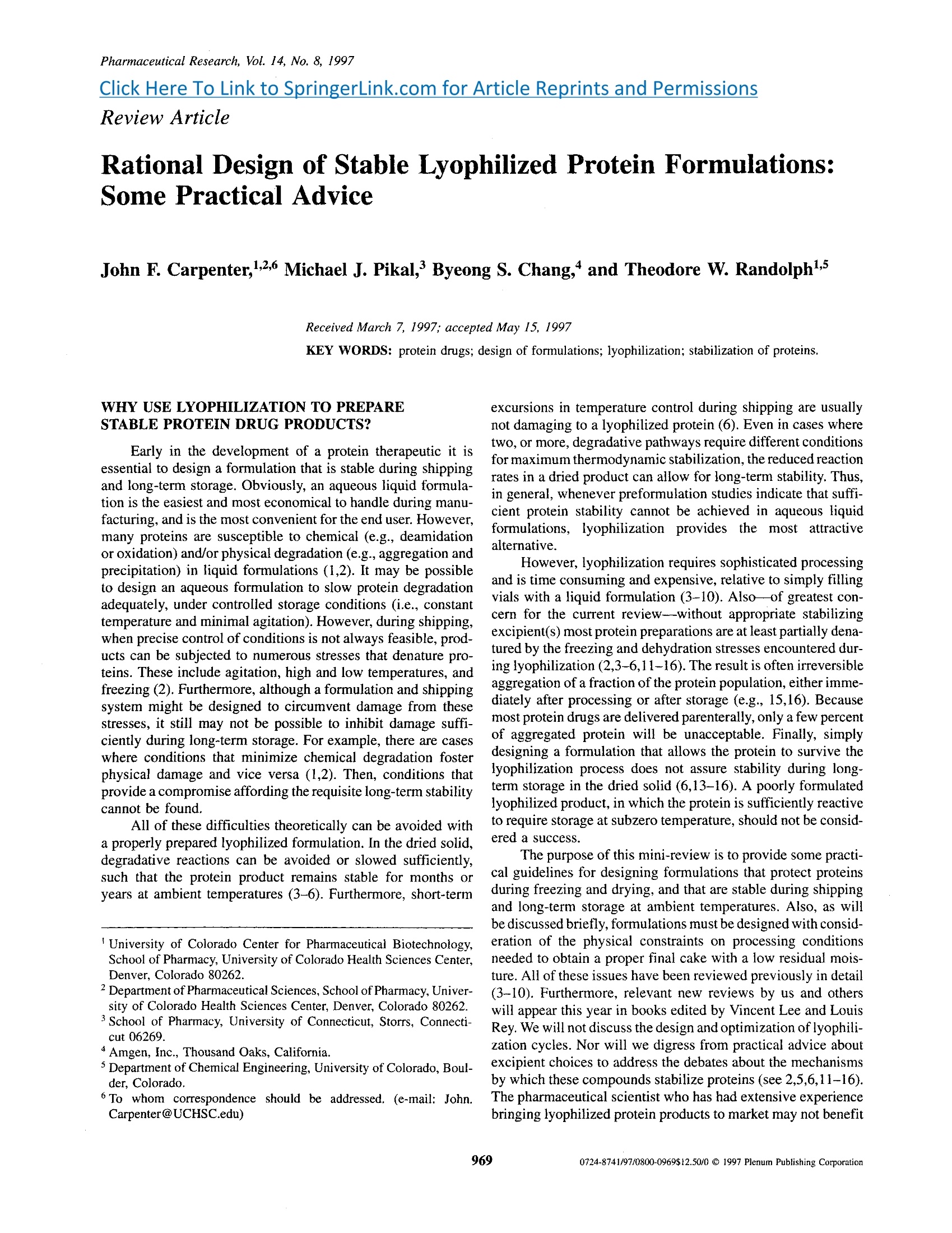
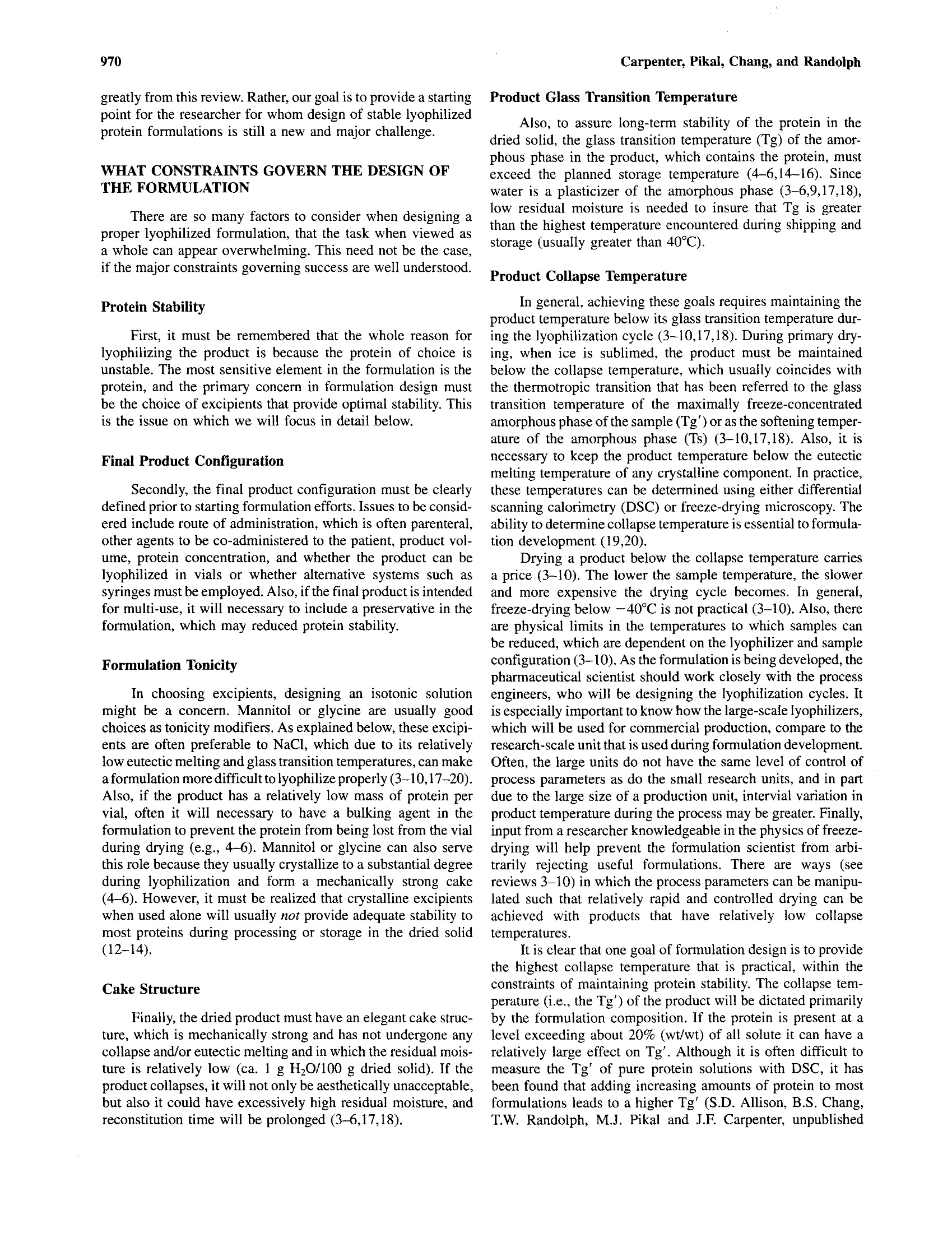
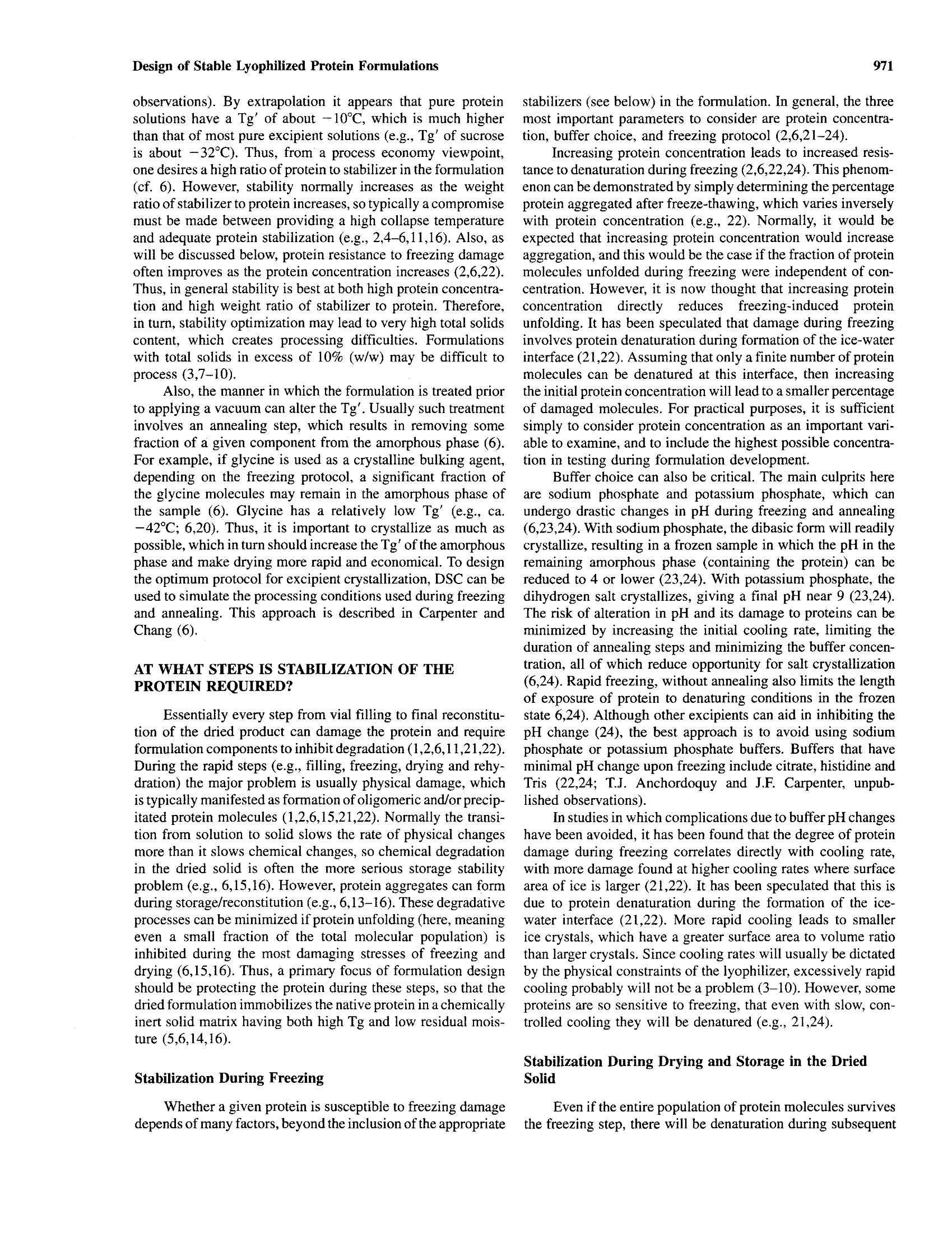

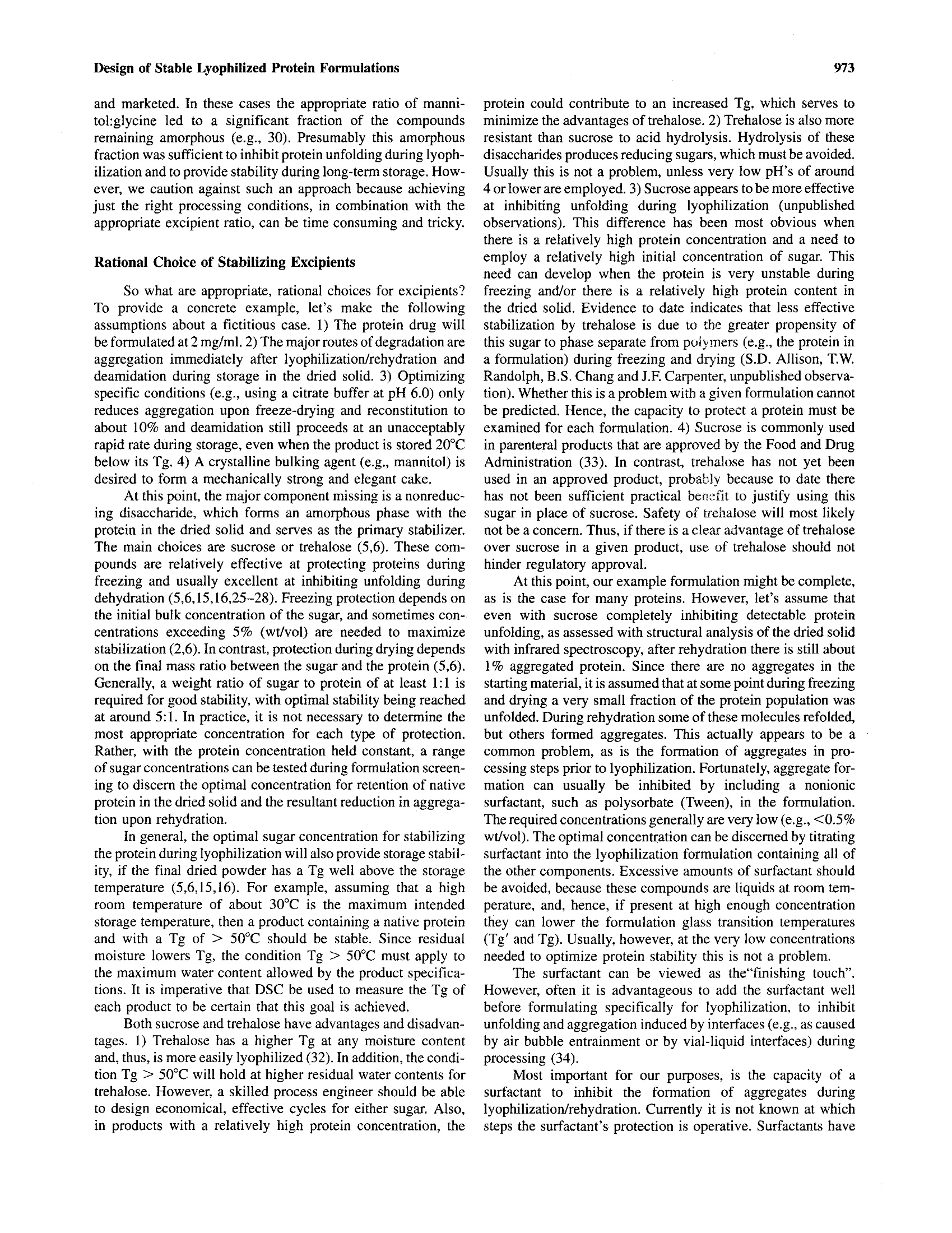
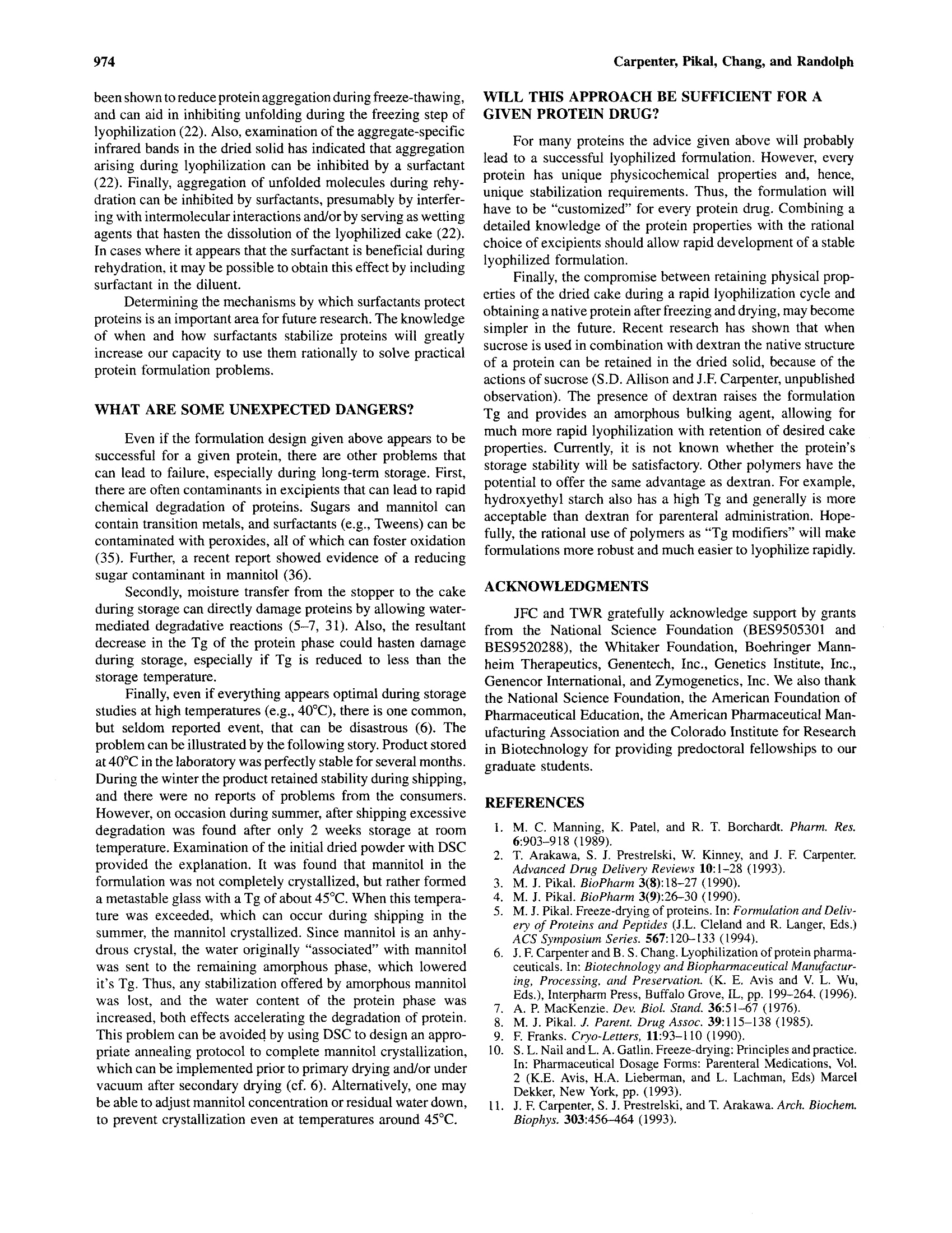
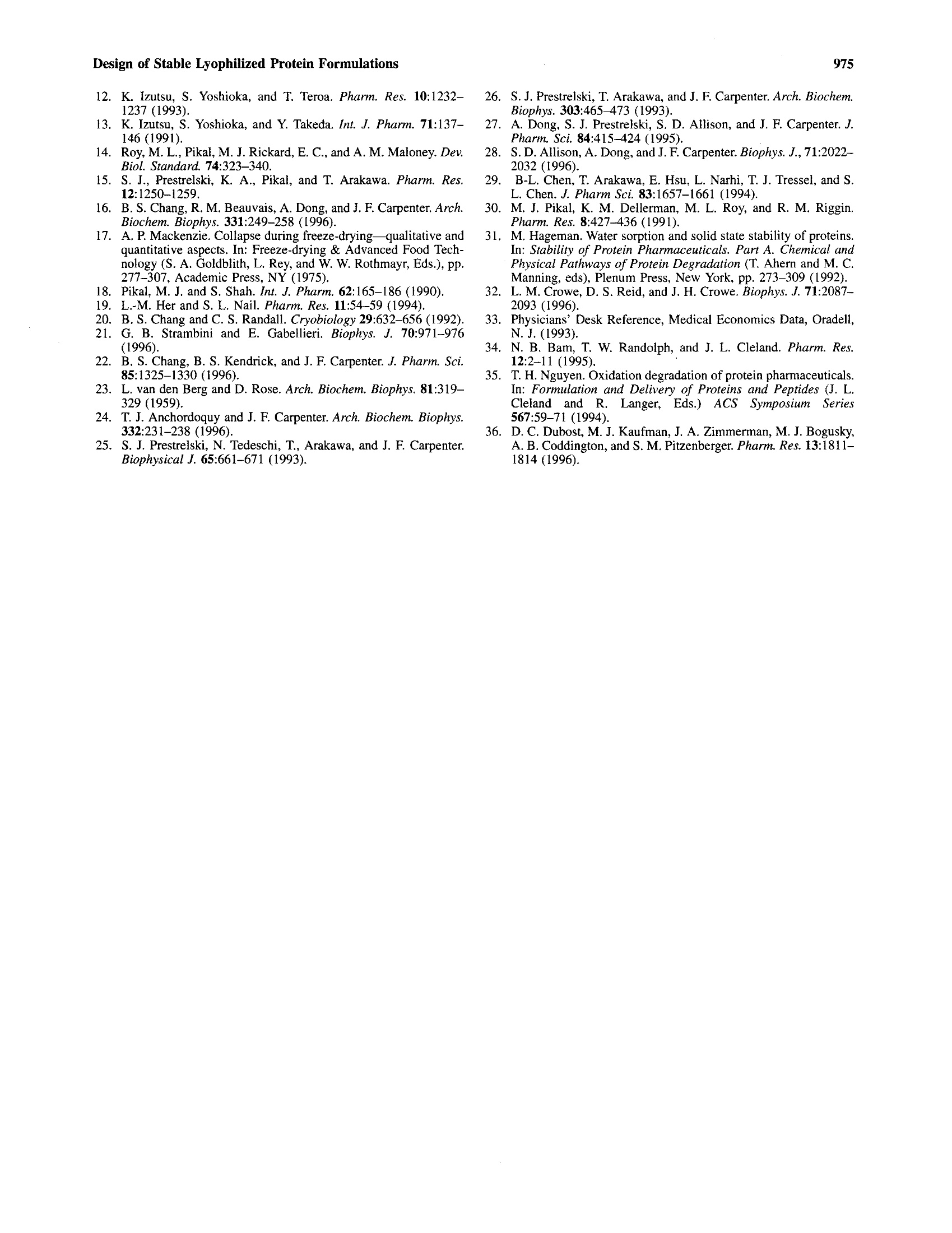
还剩5页未读,是否继续阅读?
德祥科技有限公司为您提供《稳定冻干蛋白配方的合理设计方面的实用建议》,该方案主要用于其他中-检测,参考标准--,《稳定冻干蛋白配方的合理设计方面的实用建议》用到的仪器有SP台式冻干机Virtis AdVantage Pro、Biopharma Technology冻干显微镜LyoStat5、Biopharma Micropress冻干饼强度测试仪
推荐专场
相关方案
更多
该厂商其他方案
更多






